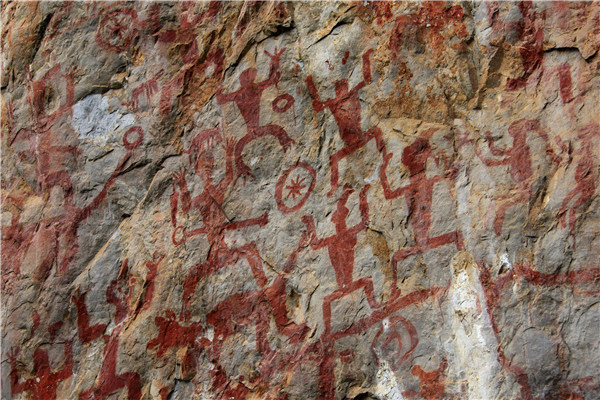
The Zuojiang Huashan Rock Art Cultural Landscape in Guangxi is the latest World Heritage Site. [Photo/China Daily]
The Zuojiang Huashan Rock Art Cultural Landscape in the Guangxi Zhuang autonomous region became China’s latest World Heritage Site on July 15.
The site includes thousands of red paintings on cliffs along more than 100 kilometers of the Zuojiang River.
Locals commonly call the site “Huashan,” which means “mountains with pictures”.
The paintings reflect the daily lives of the Luoyue people, commonly considered to be the predecessors of today’s Zhuang ethnic group.
“It is China’s first World Heritage Site of rock art, and the first World Cultural Heritage Site in Guangxi,” said Liu Shuguang, deputy director of the State Administration of Cultural Heritage. “That reflects China’s endeavor for a more representative, balanced and credible list of World Heritage Sites.”
Nevertheless, he added that more work is needed to preserve the mountains and enhance follow-up surveillance.
“We will do our best to protect and manage the site, improve its surrounding environment, and prevent forest fires,” he said.
About 1,800 images, including 1,500 human figures, have been discovered in one spot in Ningming county, covering an 8,000-square-meter area on the cliff, making it the world’s second largest rock art after the Nazca Lines in Peru.
According to Zhu Qiuping, director of the cultural relics custody office of Ningming county who has studied Huashan Rock Art for about 30 years, the pieces were created between the 5th century BC and 2nd century AD. However, it remains a puzzle why the painting suddenly stopped, and specific methods for creating these paintings on high mountains are still being studied.
“Squatting human figures are common in prehistoric rock art all over the world,” Zhu explained.
“However, nowhere else has so many repeated squatting human figures like the Zuojiang area. That shows Luoyue people’s devout attitude toward Heaven.”
He added that one possible explanation is that such a position resembles a frog, and worship of a Frog God is often seen as a wish for a good harvest among nationalities growing rice.
According to Ningming county’s government, infrastructure will be improved to build the site into a national AAAAA scenic spot in 2017.
